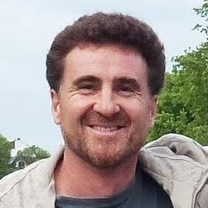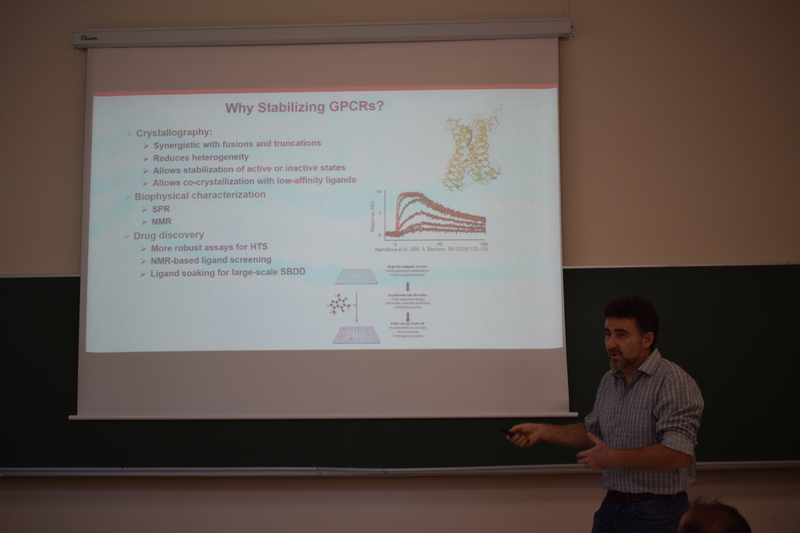Objectives
To see the presentation please click here
Abstract
Recent advances in crystallography and cryo-EM have led to structure determination for more than fifty G-protein coupled receptors (GPCRs), covering most branches of this therapeutically important 7-transmembrane superfamily of more than 800 proteins. The structures provide a solid 3D framework for computational studies of GPCR molecular interactions with ligands and allosteric modulators, characterization of their functional states and complexes with downstream effectors, as well as a platform for structure-based ligand discovery.
In this talk I will describe several new computational approaches to GPCR modelling and design developed in my lab. To predict stabilizing mutations in GPCRs we have developed a CompoMug tool as combination of sequence-based analysis, structural information, and a derived machine learning predictor1. Novel insights into the GPCR functional mechanisms can be also obtained by structural bioinformatics and molecular dynamics characterization of the protein and its allosteric co-factors, including highly conserved sodium ion and water cluster in the center of the 7TM bundle in Class A GPCRs2,3. Finally, structural pharmacology analysis of the orthosteric and allosteric ligand binding sites helps to explain selectivity and functional profiles of known drugs and drug candidates4,5. Applied to the key receptors in inflammation and pain perception pathways, including opioid, cannabinoid and angiotensin receptors, these approaches give a powerful tool for virtual screening and rational design of novel GPCR ligands with desirable functional features as molecular probes and lead candidates.
1Popov et al. (2018) Rational design of thermostabilizing mutations for G-protein coupled receptors. eLife, in press.
2Katritch et al. (2014) Allosteric sodium in class A GPCR signaling. Trends Biochem Sci. 39(5):233-44.
3Vickery et al. (2018) Intracellular Transfer of Na(+) in an Active-State G-Protein-Coupled Receptor. Structure 26:171
4Zheng et al. (2017) Structure-Based Discovery of New Antagonist and Biased Agonist Chemotypes for the Kappa Opioid Receptor. J Med Chem. 60(7):3070-81.
5Zhang et al. (2017). Structural basis for selectivity and diversity in angiotensin II receptors. Nature. 544:327-32
Short bio:
 Vsevolod (Seva) Katritch, Ph.D., Assistant Professor of Biological Sciences and Chemistry, Bridge Institute and Michelson Center for Convergent Biosciences, University of Southern California
Vsevolod (Seva) Katritch, Ph.D., Assistant Professor of Biological Sciences and Chemistry, Bridge Institute and Michelson Center for Convergent Biosciences, University of Southern California
Dr Vsevolod “Seva” Katritch is a computational structural biologist at University of Southern California (USC) and a founding member of the Bridge Institute and Michelson Center for Convergent Biosciences at USC. His research focuses on developing and applying computational tools to study molecular function of membrane proteins, specifically the superfamily of G protein-coupled receptors (GPCRs). He is one of the pioneers in structure-based discovery of ligands and in vivo probes for GPCRs, as well as in computer-assisted design of stabilized GPCR constructs for crystallization. His group works in close collaboration with crystallographers, biophysicists, molecular biologists, and medicinal chemists at the Bridge Institute, USC, the GPCR Consortium, and other institutions around the globe.
Dr. Katritch received his Ph.D from Moscow Institute of Physics and Technology, followed by postdoctoral training at Rutgers University and The Scripps Research Institute. Before joining USC, he served as a director of computational biology in a biotechnology startup and held research faculty positions at the University of California, San Diego and The Scripps Research Institute. His work has resulted in more than five patents and more than 90 publications, including ligand-discovery studies and high-impact reviews on GPCR structure and function. In 2017 he was named among Clarivate Analytics highly cited researchers in pharmacology and toxicology, as well as in the biology and biochemistry categories.

Speakers
Vsevolod (Seva) Katritch, Ph.D., Assistant Professor of Biological Sciences and Chemistry, Bridge Institute and Michelson Center for Convergent Biosciences, University of Southern California
